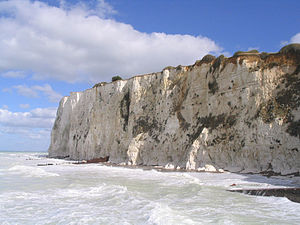
Back الطباشيري المتأخر Arabic Cretaceu Superior AST Gec Təbaşir Azerbaijani অন্তিম ক্রিটেসিয়াস Bengali/Bangla Kasna kreda BS Cretaci superior Catalan Svrchní křída Czech Oberkreide German Late Cretaceous English Cretácico superior Spanish



The Upper Cretaceous is the last geological epoch in the Cretaceous. It began 100.5 million years ago, and ended 66 million years ago.
The Cretaceous is traditionally divided into Lower Cretaceous (early), and Upper Cretaceous (late), because of the different rocks. The rocks reflect the conditions in which they were formed. From lowest to highest, it is subdivided into the Cenomanian, Turonian, Coniacian, Santonian, Campanian, and Maastrichtian ages.
The Upper Cretaceous is the time of chalk. Chalk is composed of countless millions of calcareous (CaCO3) plates called coccoliths. They are so small they can only just be seen with a light microscope; details require an electron microscope. The plates are formed by single-celled planktonic algae called coccolithophores, and were laid down in the off-shore seas.
The only other rock found in chalk is the flint, which is siliceous (silica, SiO2). This derives from those algae and animals which have skeletons of silica. Undoubtedly, this marks periods when the climate was somewhat different.
The Cretaceous was the last period when dinosaurs were the dominant land animals. Triceratops, Tyrannosaurus and Velociraptor lived at this time. The huge Mosasaurus was the dominant marine predator. In the Cretaceous period, birds became more diverse. Flowering plants developed more, and became the dominant plants on land. The Upper Cretaceous ended with the K/T extinction event.